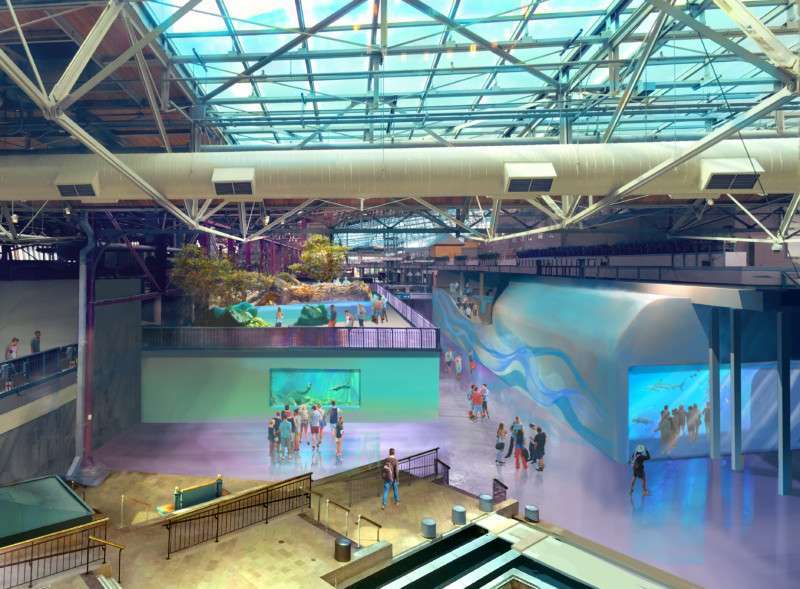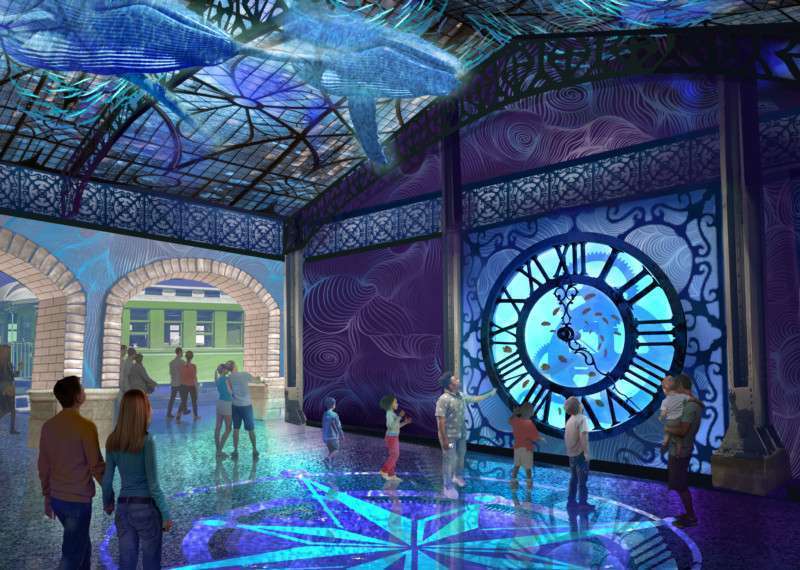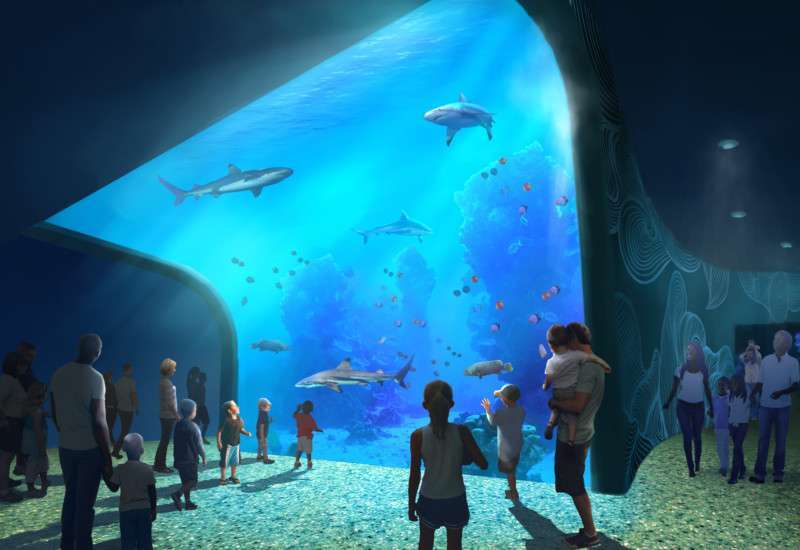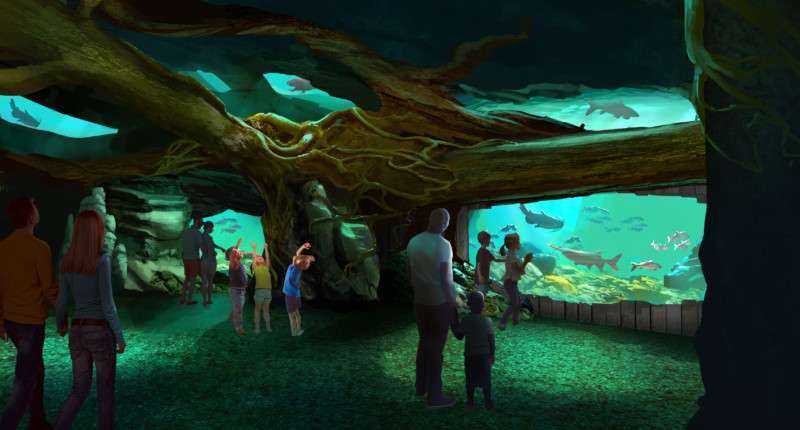LHM expands entertainment components of St. Louis Union Station with new aquarium
Interviews with PGAV and zoOceanarium by Judith Rubin
Lodging Hospitality Management (LHM) held the groundbreaking ceremony in November 2017 for the St. Louis Aquarium at Union Station. St. Louis-based LHM owns the historic, downtown train station, which is a National Historic Landmark.
The 125,000 sq.-foot, $45 million, 1.3 million-gallon St. Louis Aquarium at Union Station will house thousands of aquatic species from Earth’s rivers and oceans.
Projected opening for the new aquarium is 2019. The annual attendance projection is one million.
The aquarium project represents the second major entertainment development LHM has brought to Union Station since acquiring it in 2012 – the first was the Grand Hall Experience, an indoor, multimedia/projection mapping show that was honored with a TEA Thea Award in 2015.
LHM, headed by chairman and CEO Robert O’Loughlin and president and COO Steve O’Loughlin, has an excellent track record in reviving the performance of hospitality-based developments and also owns the adjoining, 539-room St. Louis Union Station Hotel. Future entertainment development is in the works, including an observation wheel.
Under contract to LHM, and reporting to Chad Smith (vice president of design and construction, LHM) are PGAV Destinations as designer and zoOceanarium Group as operator of the new aquarium.
Judith Rubin interviewed PGAV’s Emily Howard (vice president) and Justin Stichter (project architect/attraction designer) and zoOceanarium’s Erin Clark (director of animal projects) about the project and each company’s role.
The entry clock will connect the historical architecture to the modern aquarium. Courtesy of PGAV
Tell us about the PGAV team.
 Emily Howard: The PGAV internal team consists of architects, exhibit designers, graphic designers, renderers, interior designers and various other disciplines within PGAV.
Emily Howard: The PGAV internal team consists of architects, exhibit designers, graphic designers, renderers, interior designers and various other disciplines within PGAV.
Our team of consultants and engineers is integral to the success of the project. For this project, PGAV is working with some of the best in the world. We are partnering with TJP for life support engineering, and exp for MEP engineering. Local structural engineer Alper Audi and MLA out of Seattle are engineering the specialty aquatic concrete and working to preserve as much of the existing structure as possible. Lighting design is by Oculus Light Studio and local engineer Frontenac Engineering is the civil engineer. Food service provider is DDG. PGAV is also working closely with Moondog Animation Studio to develop the audiovisual components throughout the Aquarium.
How are PGAV and zoOceanarium teams interacting for this project? How does having the operator on board at the start help the process?
 Erin Clark: We’re continually bouncing recommendations and ideas off of each other in developing a unique but operationally-feasible attraction. PGAV is one of the most experienced aquarium design companies in the world, which certainly makes our job much easier. Our typical conversations largely revolve around design considerations related to general operations and creating exhibits that are appropriate for the animals. This often includes such things as materials, temperature, the depth, height of the tanks, the turning radius needed by certain kinds of fish, as well as specific lighting requirements.
Erin Clark: We’re continually bouncing recommendations and ideas off of each other in developing a unique but operationally-feasible attraction. PGAV is one of the most experienced aquarium design companies in the world, which certainly makes our job much easier. Our typical conversations largely revolve around design considerations related to general operations and creating exhibits that are appropriate for the animals. This often includes such things as materials, temperature, the depth, height of the tanks, the turning radius needed by certain kinds of fish, as well as specific lighting requirements.
Having the operator onboard during the design process has numerous advantages. Foremost is the fact that our team is involved from the very beginning, so there is no learning period with getting it up and running. Basically, we have the full period of design and construction to develop facility-specific SOPs, staff onboarding schedule, the educational components, etc… so we hit the ground running as soon as the construction company turns it over to us.
Justin Stichter: There are three avenues we design for: animal-centric, guest-centric, and operations-centric. Having the operator on board helps ensure we traverse all those avenues effectively and keep them in balance.
Erin: The tanks and exhibits must be designed specifically for the animals that will live in them. An additional level of complexity is added because many of the exhibits will house several different types of animals.
Tell us about the overarching story informing the design.
Justin: Story is often the starting point for a successful project and the driver of decisions. Sometimes we have to educate the client about story and why it is so important, but in this case, Bob [O’Loughlin] is a storyteller himself, a lover of history.
The story was an interesting genesis, because this building, while it has a significant architectural history, has nothing to do with fish per se. So we had to find a way to tell a story that combines fish and trains. The common element became the journey from the world’s waterways and back.
Emily: That journey becomes the undercurrent; talking about rivers, how they flow into our oceans, starting right here at home with the Mississippi and Missouri Rivers. That confluence is where we start – everything works together to get from here out to the ocean and this ties into the greater global and conservation stories.
Justin: One of the directives was how to differentiate this, as a regional aquarium, from other regional aquariums. Tying it to the river city heritage that is the origin of St. Louis is important – that common thread of transport and cultural significance, our people and the river.
Erin: The design includes numerous components where guests can actually interact with the exhibits. This interactivity allows for the visitor to become an active part of the story and the journey from river to ocean.
How does the new aquarium fit into the master plan for the property?
 Justin: It will serve to anchor the overall entertainment district that LHM is building, which includes the observation wheel, outdoor shopping and dining, a lake show and so on. Families will, ultimately, be able to come and spend several hours there.
Justin: It will serve to anchor the overall entertainment district that LHM is building, which includes the observation wheel, outdoor shopping and dining, a lake show and so on. Families will, ultimately, be able to come and spend several hours there.
Everything will manifest the aquatic vernacular and play off the existing Union Station architecture. This will not be a passive journey for the guest, but rather a very immersive journey, and everything will fit the story.
Tell us something about the animal welfare, education and conservation mission of the facility.
Erin: We are fortunate to have great partners who are committed to developing a facility that exceeds industry standards in terms of providing a phenomenal level of animal welfare. Everyone involved is also equally committed to a facility that is educationally and conservationally focused.
Geographically, we’re in a unique position here at the confluence of the Mississippi and Missouri Rivers to highlight the importance of these rivers, and the life within and along them and the region. Simultaneously, we also need to recognize the impact we as people have on these rivers, and how our actions here in Saint Louis can impact everything down river and in the Gulf.
The Mississippi River exhibit will take visitors in a themed environment below the river’s surface. Courtesy of PGAV
Justin: It is our desire and our passion to educate people, to get them to care. We’re touching the heart to teach the mind, and to do that, we have to connect with people. If people come away caring for animals, then we win. Our three main priorities are human welfare, animal welfare and story.
Tell us about the process of staffing and training for the new aquarium.
Erin: LHM and zoOceanarium Group have been working together to develop staff onboarding schedules to ensure we have proper time to recruit and then train staff. We will have a good combination of highly experienced staff as well as individuals who are new to working with aquariums. The goal from the onset is to create a single, cohesive team made up of people from all different disciplines; customer service, animal care, advertising, finance, and cleaning. Everyone has to work together, so all the staff we work with go through a training program. Having started my career as an animal trainer, cleaning exhibits and working my way up from there, I can see a facility from all aspects.
We have been filling some key positions recently and will fill the rest closer to opening.
A lot of the maintenance work is focused on life support. For that, we need people who are very experienced with that equipment, someone who understands from the animal perspective the importance of maintaining a specific environment.
What’s it like for PGAV as a St. Louis-based firm, to be doing this high-profile, local project?
Emily: It sure is fun to work in your home town! The city is excited about it, and I get a lot of questions from friends who want the inside track (and I can’t give it to them). All I can say is “it’s gonna be fun.” At PGAV we do a lot of local projects, working for the Saint Louis Zoo, which happens to be one of the best in the world, the St Louis Cardinals Hall of Fame and Museum and the St Louis Science Center, to name a few. But this is a whole new thing. I think St. Louis is yearning for an aquarium and we’re honored to be part of it.
Justin: My kids are growing up here, and there’s a pride of working in your own back yard. I believe this aquarium will be around for a long time, and become part of the legacy of great attractions in this great city. It’s strengthened by the fact that LHM is doing it, because of their deep understanding of hospitality. When you think about an attraction like this, hospitality comes into it very quickly.
Erin: It’s really exciting. In the time I have been in St. Louis, I have discovered that there is a lot of excitement around bringing back to St. Louis Union Station the luster it had in years past. I hear so many stories from people I meet about how this was the place to be during their youth. We are excited to be a part of creating something at Union Station that the City can be proud of. • • •









